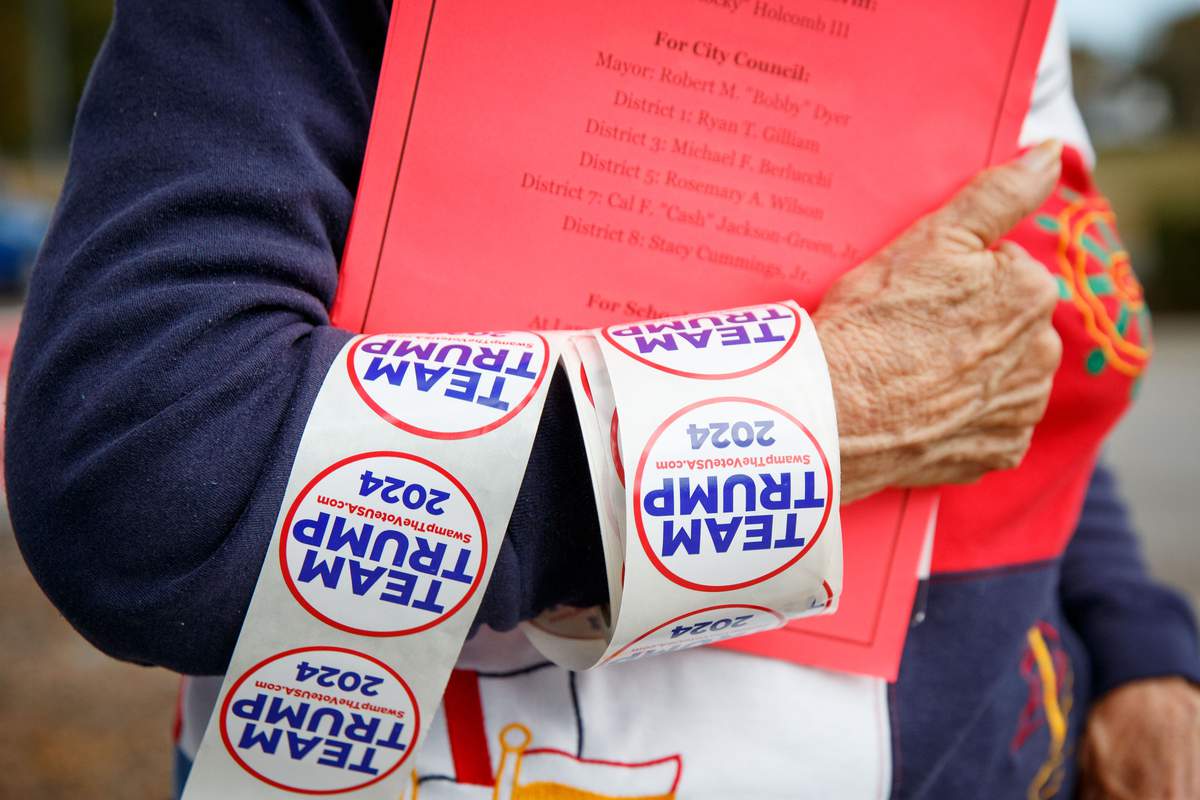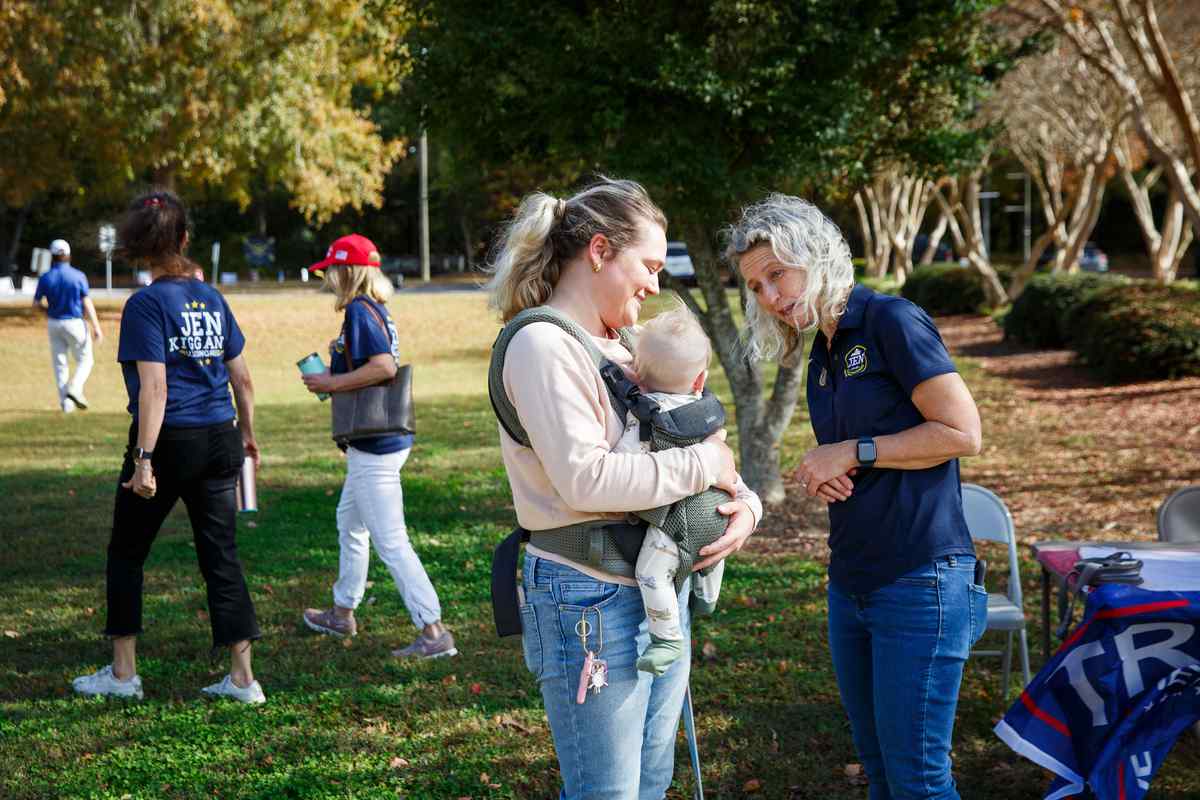
A volunteer hands out Trump stickers on Election Day in Virginia Beach on Tuesday.
13:03 JST, November 7, 2024
The Northern Virginia suburbs shifted slightly toward President-elect Donald Trump in Tuesday’s election, defying conventional wisdom about the D.C. area’s status as an increasingly blue bulwark, according to unofficial returns.
In a state where Democrats rallied heavily around Vice President Kamala Harris’s presidential campaign, some in the party were caught off guard by a GOP surge that also saw moderately conservative areas take on a deeper shade of red.
“At this point, I’m perplexed,” said Jeff Kent, chair of the Spotsylvania Democratic Committee in a county that Trump won by almost two more percentage points this year than in 2020. “I don’t have an explanation for how things came out. The realities are not syncing up from what I see in my head to what is clearly evidenced in the results.”
The rightward movement in vote-rich counties such as Loudoun, Prince William, Fauquier and even the Democratic stronghold of Fairfax helped Trump improve his performance in Virginia over 2020. But the Republican still lost the state to Harris by a little more than five percentage points, with the final count not yet complete.
That’s better than Trump’s 10-point loss to President Joe Biden four years ago and comparable to his five-point loss to Hillary Clinton in 2016. Harris won the immediate D.C. suburbs – Fairfax, as always with Democratic candidates, helped put her over the top – as well as Loudoun, Prince William and Stafford counties in the exurban parts of Northern Virginia. But her margins of victory were two to five points lower than Biden’s.
Some of the credit for the purple blush should go to Gov. Glenn Youngkin (R) and his ability to connect with suburban voters, University of Mary Washington political analyst Stephen J. Farnsworth said. “The movement of suburban voters into the D column had really been accelerating before Youngkin’s victory [in 2021],” Farnsworth said, referring to the Republican’s narrow win in that year’s gubernatorial race.
Youngkin, who had cultivated an image as a friendly basketball dad, went all-in for Trump this year, appearing with him at rallies and shouting himself hoarse to put Virginia in play for the MAGA leader.
He failed to negotiate a win. But his supporters say the better-than-last-time showing for Trump will burnish the governor’s national stature in the Republican Party as someone who can bridge the gap between hardcore MAGA and more moderate suburbanites.
“President Trump took Virginia from a D plus-10 state to a close five-point race,” Youngkin political strategist Matthew Moran, whose firm did direct mail for the Trump campaign in some states, said in a text to The Washington Post. “That’s pretty amazing. The popularity of the governor and his successful policies also certainly played a big part in that. If Virginia Democrats want to pretend like the Commonwealth is some progressive bastion, they will pay the price in 2025.”
Youngkin is entering the final year of his term in January, and the Virginia constitution prohibits governor’s from succeeding themselves. His new bromance with Trump has sparked whispers in Richmond that Youngkin could be in line for a Cabinet position, though Farnsworth cautioned that Virginians take a dim view of a governor walking away before his term is complete. That could nix any idea of running for future office, such as the U.S. Senate, he said.
David Richards, political science chairman at the University of Lynchburg, said Trump’s national victory complicates – or at least postpones – Youngkin’s highest future ambitions. Almost immediately after opting out of a last-minute 2024 presidential bid of his own late last year, Youngkin began laying the groundwork for a potential 2028 presidential run. But now he would probably have to compete against a sitting vice president, JD Vance, for the GOP nomination.
“I think Glenn Youngkin had the worst [post-election] morning of anybody because his presidential hopes are gone,” Richards said. “He’s got to be a little frustrated. Had Trump lost, his pathway to running for president would have been very clear.”
Youngkin did not make any public appearances Wednesday but issued a statement congratulating Trump and Vance. “The American people have spoken overwhelmingly to return common sense, strength, and leadership back to the White House,” he said.
Meanwhile, Virginia Democrats were taking stock. Sen. Tim Kaine (D) was projected to win a third term, and the party’s other incumbents unofficially prevailed in congressional contests.

Rep. Jen Kiggans (R-Virginia) talks with Lauren Rigell and her 6-month-old son, Rhett, in Virginia Beach on Tuesday.

Yevgeny “Eugene” Vindman, a Democrat who won Virginia’s 7th District congressional seat, and his wife, Cindy, in Fredericksburg, Virginia, on Tuesday.
In the competitive 2nd District, a red seat anchored in Virginia Beach, Rep. Jen Kiggans (R) successfully fended off a late surge of momentum from Democratic challenger Missy Cotter Smasal, according to the Associated Press.
In the 7th District, an open blue seat anchored in Fredericksburg, Democrat Yevgeny “Eugene” Vindman prevailed over Republican Derrick Anderson in another extremely tight race that the AP called on Wednesday evening.
But the stronger showing by Republicans in many Northern Virginia districts left some Democrats wondering what new dynamics were at work.
Kent, who helped Democrats flip control of the school board in Spotsylvania County – an exurban-to-rural community outside Fredericksburg – said there were “fundamental issues” such as abortion rights that he thought would bring moderate Republicans to cast their ballots for Harris and other Democrats.
Virginia House of Delegates Speaker Don Scott (D-Portsmouth) said he could only assume voters were betting that Trump was not serious about his plans to eliminate the Education Department and shrink federal agencies or relocate them to other states, which could cost Virginia thousands of jobs.
But Scott said he took several lessons from the national and statewide outcomes. Voters, he said, feel uncertainty in their lives and want a stronger message from Democrats.
“I think the economy was a huge issue. I think inflation is real,” he said, adding that Democrats have delivered a robust economic recovery but that ordinary people still feel strapped – particularly in the expensive Northern Virginia market where the cost of living is far higher than the rest of the state. “I think that message didn’t resonate with voters, and I think that ended up hurting us at some point.”
Asked if he gave Youngkin some credit for the shift toward Republicans, Scott scoffed. “They lost!” he said. “Thank you, Gov. Youngkin, for delivering another ‘L’ for Donald Trump.”
Democrats did improve their performance in some parts of the state. In suburban Chesterfield County outside Richmond, for instance, Harris won by a wider margin this year than Biden did in 2020, according to the unofficial results. And that’s in a growing county that was solidly red just a few years ago.
Kelsey Carolan, spokeswoman for the Democratic Party of Virginia, noted that Virginia was among a group of Eastern states in which neither major party spent big dollars on television advertising, believing Democrats had a relatively secure advantage. Those other states – including Connecticut, New York, New Jersey and Maryland – all saw Trump surge by eight to 11 points, while his improvement in Virginia was about 4.8 points, Carolan said.
Mark Rozell, dean of the Schar School of Policy and Government at George Mason University, said the better Republican results in Northern Virginia could be understood through three lenses: One, the economy – especially tough in an area with skyrocketing housing prices. Two, low Democratic enthusiasm, partly the product of an assumption that Democrats will always win there anyway.
And three, most surprisingly, immigration. “Northern Virginia is the commonwealth’s richest melting pot,” Rozell wrote in an email to The Post. “Although the increased diversity of the region would typically help a Democratic campaign, Trump performed especially well for a Republican with certain minority groups.”
National exit surveys showed that while Harris won the Hispanic vote, she did so by only eight percentage points, compared with a 33-point margin for Biden, Rozell said. “Democrats in Virginia need large margins and robust turnouts among minority populations. Trump did well to hold down his losses with minority voters in Northern Virginia, while driving up his predominantly White rural base,” he said.
Moran, Youngkin’s political strategist, agreed. “It’s clear that Latinos and suburban women were the movers,” he said.
Jacob Alderman, chair of the Prince William Republican Committee, said Republicans performed better in Northern Virginia communities like his because the party started leaning into the demographic change that has transformed the more exurban parts of the region.
A onetime farming community, Prince William County was reliably Republican before a population boom in the last decade – fueled mostly by Latinos and African Americans – turned the area into a diverse political bellwether and then a reliably blue stronghold. White people became the minority in 2010, and just one Republican is left among its dozen seats in the state legislature.
Alderman said that while Democrats had assumed most non-White voters would flock to them, his side of the aisle has fought hard to extend its message of less regulation, lower taxes and more public safety into these communities of color – including in spaces where Republicans may not have thought to campaign just a few cycles ago, such as mosques, Black fraternities and Sikh gurdwaras.
Alderman’s group spent more than $10,000 during this election to send out Spanish-language text messages, mailers and radio ads and printed its voter guides to distribute at the polls in Spanish, too – a strategy that was inspired by both the Republican chapter in neighboring Loudoun County as well as Trump’s outreach to voters of color, he said.
Rep. Gerry Connolly (D-Virginia), who was projected to win a ninth term Tuesday night, acknowledged that areas like his Fairfax-based congressional district saw stronger performance by Republicans but said he wasn’t worried. “So what? Northern Virginia is still hostile territory for Donald Trump,” he said. “When you’re only getting 30 or 40 percent of the vote, I wouldn’t call that strength. It may be an improvement, but that reflects the improvement across states. … There’s still a solid Democratic majority, and it’s important not to lose track of that.”
"News Services" POPULAR ARTICLE
-

American Playwright Jeremy O. Harris Arrested in Japan on Alleged Drug Smuggling
-

Japan’s Nikkei Stock Average as JGB Yields, Yen Rise on Rate-Hike Bets
-

Japan’s Nikkei Stock Average Licks Wounds after Selloff Sparked by BOJ Hike Bets (UPDATE 1)
-

Japan’s Nikkei Stock Average Buoyed by Stable Yen; SoftBank’s Slide Caps Gains (UPDATE 1)
-

Japanese Bond Yields Zoom, Stocks Slide as Rate Hike Looms
JN ACCESS RANKING
-

Tokyo Economic Security Forum to Hold Inaugural Meeting Amid Tense Global Environment
-

Keidanren Chairman Yoshinobu Tsutsui Visits Kashiwazaki-Kariwa Nuclear Power Plant; Inspects New Emergency Safety System
-

Imports of Rare Earths from China Facing Delays, May Be Caused by Deterioration of Japan-China Relations
-

University of Tokyo Professor Discusses Japanese Economic Security in Interview Ahead of Forum
-

Japan Pulls out of Vietnam Nuclear Project, Complicating Hanoi’s Power Plans
























